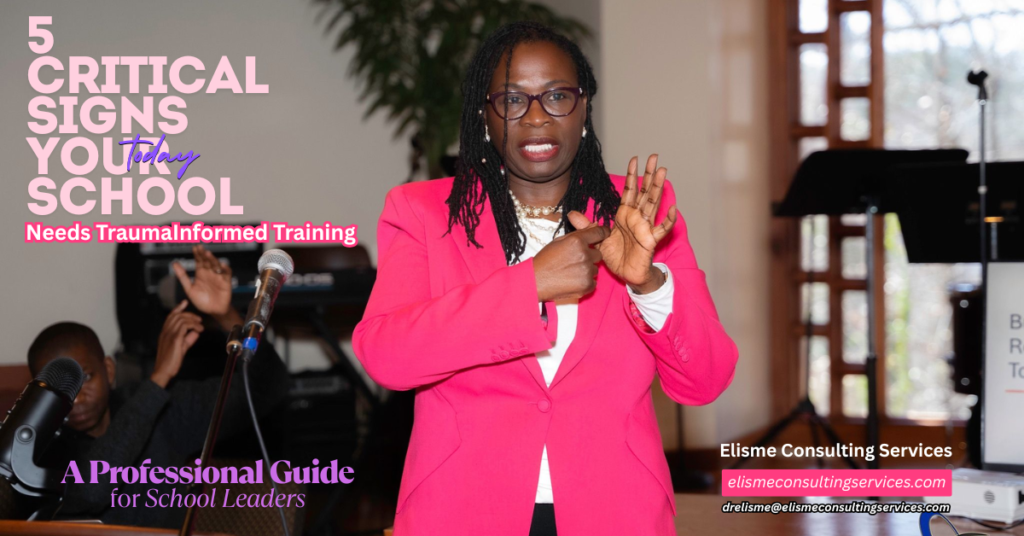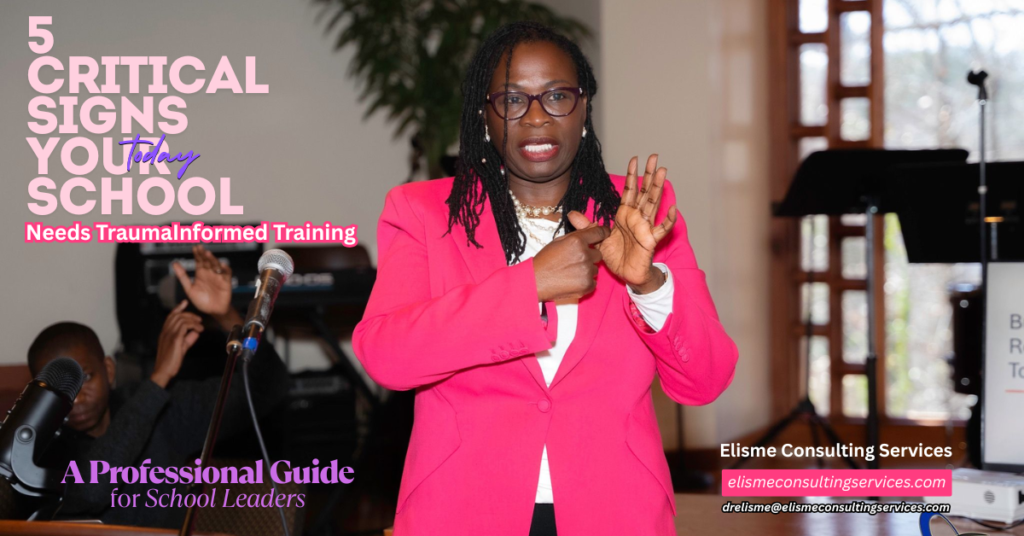
A Professional Guide for School Leaders
Is your school truly equipped to support trauma-affected students? This guide reveals five critical indicators that your staff may need professional trauma-informed training.
Sign #1: Rising Behavioral Incidents Despite Consistent Discipline
What You’re Seeing:
-
- Repeated infractions from the same students
- Traditional consequences aren’t creating lasting change
-
- Students seem unable to “learn” from their mistakes
-
- Escalating behavioral patterns
The Hidden Truth: What looks like defiance often masks a trauma response. Without proper training, staff may inadvertently reinforce trauma patterns through traditional discipline approaches.
Real Example: A middle school reduced suspension rates by 40% after implementing trauma-informed approaches that replaced punitive measures with regulation-based interventions.
Sign #2: Teacher Burnout and Compassion Fatigue
What You’re Seeing:
-
- Increased staff absences
- Emotional exhaustion in team meetings
-
- Expressions of helplessness about challenging students
-
- Teachers feeling personally affected by student struggles
The Hidden Truth: Without proper training in trauma-informed boundaries and self-care strategies, teachers absorb secondary trauma while feeling powerless to help their students effectively.
Impact on Your School: Teacher burnout leads to higher turnover rates, decreased instructional quality, and reduced student outcomes.
Sign #3: Widening Academic Gaps Despite Intervention Programs
What You’re Seeing:
-
- Students who are “present but not learning”
- Inconsistent academic performance
-
- Difficulty with attention and memory
-
- Limited success with traditional interventions
The Hidden Truth: Trauma significantly impacts cognitive function and memory formation. Traditional academic interventions often fail because they don’t address the underlying neurological impacts of trauma.
By the Numbers: Schools with trauma-informed practices report up to 50% improvement in academic engagement among affected students.
Sign #4: Ineffective Parent-School Partnerships
What You’re Seeing:
-
- Low parent engagement
- Defensive reactions to school communication
-
- Difficulties building trust with families
-
- Misalignment between home and school support
The Hidden Truth: Many parents have their own trauma histories that affect their relationship with educational institutions. Without trauma-informed communication strategies, schools may unknowingly create barriers to partnership.
Solution Preview: Trauma-informed training provides specific strategies for building trust and creating safe spaces for family engagement.
Sign #5: Inconsistent Staff Responses to Student Needs
What You’re Seeing:
-
- Different approaches to similar situations
- Lack of common language around behavior
-
- Inconsistent results from interventions
-
- Staff disagreements about appropriate responses
The Hidden Truth: Without a shared understanding of trauma’s impact and unified response strategies, staff efforts may conflict and reduce effectiveness.
The Power of Training: Schools report 80% higher success rates in managing challenging behaviors when all staff receive consistent trauma-informed training.
Take Action Now
If you recognized two or more of these signs in your school, it’s time to consider professional trauma-informed training.
The Cost of Waiting:
-
- Continued staff burnout
- Persistent behavioral challenges
-
- Widening achievement gaps
-
- Missed opportunities for student healing
The Benefits of Training: ✓ Unified, effective staff responses ✓ Improved student outcomes ✓
Reduced behavioral incidents ✓ Stronger school community ✓ Enhanced teacher satisfaction
Next Steps
Ready to transform your school’s approach to trauma?
-
- Schedule a free consultation to discuss your school’s specific needs
- Learn about our comprehensive training programs
-
- Join our community of trauma-informed educators
Contact Information:
Dr. Erlange Elisme, Trauma-Informed Education Specialist
(678) 595-6446
drelisme@elismeconsultingservices.com
www.elismeconsultingservices.com
Bonus Resource
Download our companion guide: Quick-Start Strategies for Creating a Trauma-Sensitive Classroom

